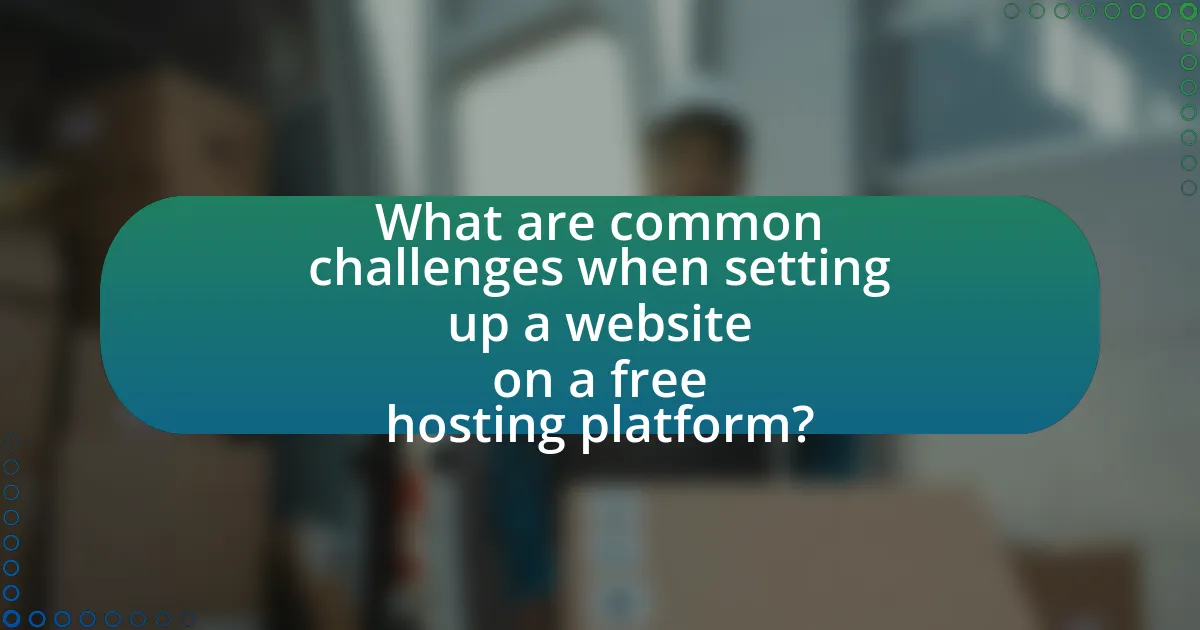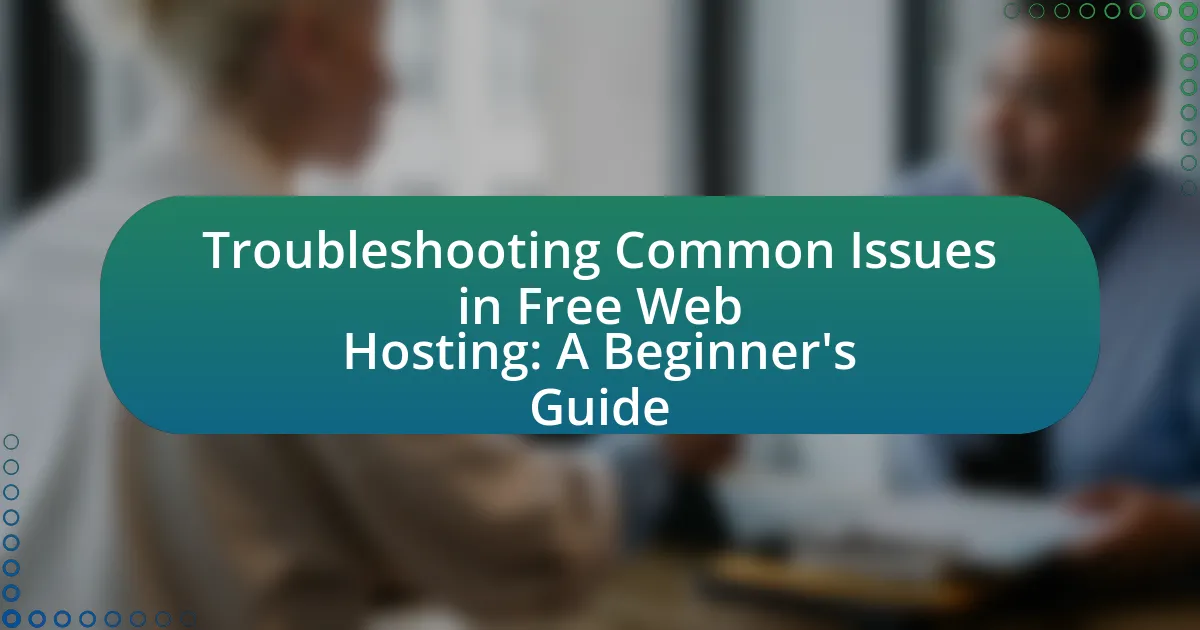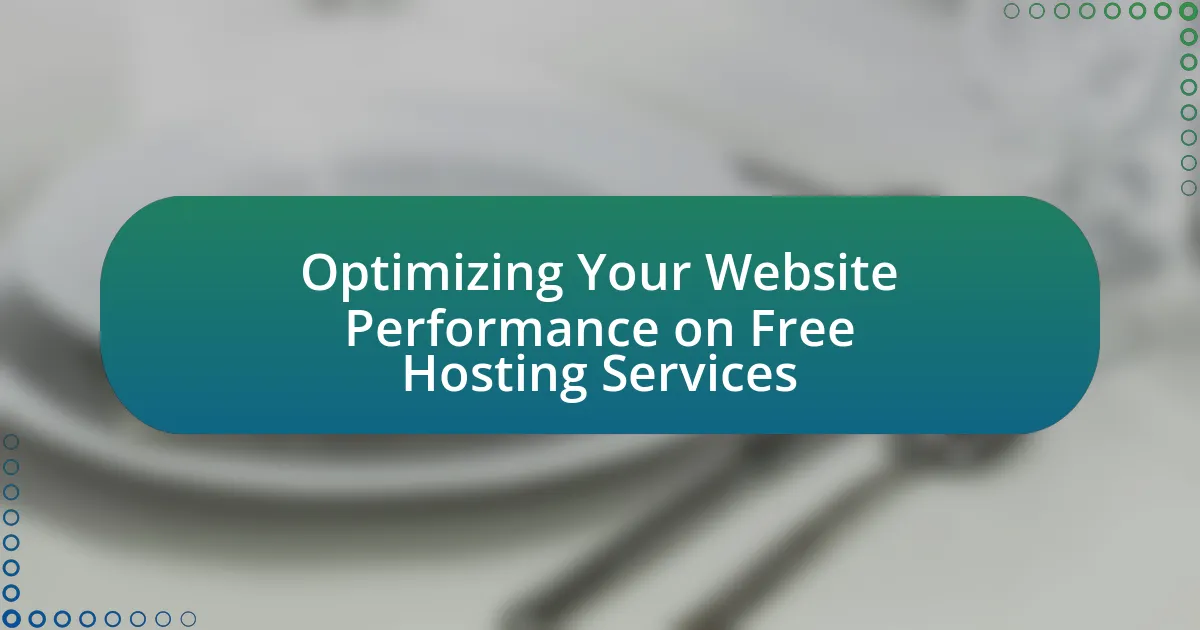The article provides a comprehensive step-by-step guide for individuals looking to set up their first website on a free hosting platform. It defines free hosting platforms, highlighting their differences from paid options, including limitations such as restricted storage, bandwidth, and lack of customer support. Key features to consider when selecting a free hosting service are discussed, along with the advantages of using these platforms for beginners. The article also outlines the process of creating an account, choosing a domain name, designing the website, and optimizing it for performance, while addressing common challenges and best practices for maintenance and promotion.

What is a Free Hosting Platform for Websites?
A free hosting platform for websites is a service that allows individuals or organizations to host their websites without incurring any costs. These platforms typically provide limited storage space, bandwidth, and features compared to paid hosting services. For example, popular free hosting platforms like WordPress.com and Wix offer users the ability to create and publish websites at no charge, although they may include advertisements and restrictions on customization.
How do free hosting platforms differ from paid options?
Free hosting platforms differ from paid options primarily in terms of features, reliability, and support. Free hosting typically offers limited storage, bandwidth, and functionality, often including advertisements on user sites, while paid hosting provides more resources, enhanced performance, and customer support. For instance, a study by HostingAdvice in 2021 indicated that paid hosting services can offer uptime guarantees of 99.9%, compared to the often lower reliability of free services. Additionally, paid options frequently include domain registration, SSL certificates, and advanced security features, which are usually absent in free hosting plans.
What are the limitations of using free hosting platforms?
Free hosting platforms have several limitations, including restricted storage space, limited bandwidth, and lack of customer support. These platforms often impose caps on the amount of data you can store and the traffic your site can handle, which can hinder growth and performance. Additionally, many free hosting services display ads on your website, reducing professionalism and user experience. Security features are typically minimal, increasing vulnerability to attacks. Furthermore, users may face restrictions on custom domain names, forcing them to use subdomains that can diminish credibility. These limitations can significantly impact the functionality and scalability of a website.
What features should you look for in a free hosting platform?
When selecting a free hosting platform, prioritize features such as storage capacity, bandwidth limits, uptime reliability, and customer support. Storage capacity should be sufficient to accommodate your website’s files, while bandwidth limits determine how much traffic your site can handle. Uptime reliability is crucial, as it indicates the percentage of time the server is operational; a reliable host typically offers at least 99.9% uptime. Additionally, customer support options, including live chat or email assistance, are important for resolving issues quickly. These features collectively ensure a functional and accessible website experience.
Why choose a free hosting platform for your first website?
Choosing a free hosting platform for your first website allows you to minimize costs while gaining essential experience in web development. Free hosting services typically provide user-friendly interfaces and basic features that are ideal for beginners, enabling them to learn how to manage a website without financial pressure. According to a survey by HostingAdvice, 70% of new website owners prefer free hosting options to test their ideas before investing in paid services. This approach helps users understand their needs and the functionalities required for future growth, making it a practical choice for those starting their online journey.
What are the advantages of starting with a free hosting platform?
Starting with a free hosting platform offers several advantages, including cost savings, ease of use, and accessibility. Cost savings are significant as users can launch their websites without any financial investment, making it ideal for beginners or those testing ideas. Ease of use is another advantage, as many free hosting platforms provide user-friendly interfaces and templates, allowing users to create websites quickly without technical expertise. Accessibility is also enhanced, as free hosting platforms often require minimal setup and can be accessed from anywhere with an internet connection, enabling users to manage their sites conveniently.
How can a free hosting platform help beginners?
A free hosting platform can help beginners by providing an accessible environment to create and manage their first website without financial investment. This allows novices to experiment with web design, learn coding basics, and understand website functionality in a risk-free setting. According to a survey by HostingAdvice, 70% of new website owners reported that free hosting services enabled them to gain practical experience and confidence before transitioning to paid options.

How do you select the right free hosting platform?
To select the right free hosting platform, evaluate the platform’s features, reliability, and user support. Key features to consider include storage space, bandwidth limits, and ease of use, as these directly impact website performance and user experience. Reliability is crucial; choose a platform with a proven uptime record, ideally above 99.9%, to ensure your website remains accessible. Additionally, assess the availability of customer support, as responsive assistance can help resolve issues quickly. Platforms like WordPress.com and Wix are popular choices due to their user-friendly interfaces and robust features, making them suitable for beginners.
What criteria should you consider when choosing a free hosting platform?
When choosing a free hosting platform, consider the platform’s reliability, storage capacity, bandwidth limits, and support options. Reliability is crucial as it affects website uptime; platforms with a proven track record of high uptime percentages, typically above 99%, are preferable. Storage capacity should meet your website’s needs, with many free hosts offering between 1GB to 10GB. Bandwidth limits are also important; platforms that provide unlimited bandwidth are ideal for accommodating traffic spikes. Lastly, assess the support options available; platforms that offer community forums, tutorials, or live chat support can significantly enhance your experience.
How important is customer support in a free hosting platform?
Customer support is crucial in a free hosting platform because it directly impacts user experience and problem resolution. Users of free hosting services often encounter technical issues or limitations that require assistance, and effective customer support can facilitate quick solutions, enhancing user satisfaction. According to a survey by Zendesk, 82% of customers have stopped doing business with a company due to poor customer service, highlighting the importance of responsive support in retaining users. Therefore, robust customer support can significantly influence the overall success and usability of a free hosting platform.
What role does uptime play in selecting a free hosting platform?
Uptime is critical in selecting a free hosting platform because it directly affects website availability and user experience. A high uptime percentage, ideally above 99.9%, ensures that the website remains accessible to visitors, which is essential for maintaining traffic and engagement. For instance, if a hosting service experiences frequent downtimes, it can lead to lost visitors and potential revenue, as studies show that even a few seconds of downtime can significantly impact user satisfaction and conversion rates. Therefore, evaluating uptime guarantees and historical performance data is essential when choosing a free hosting platform.
Which popular free hosting platforms are available?
Popular free hosting platforms include WordPress.com, Wix, Weebly, and GitHub Pages. WordPress.com offers a user-friendly interface and a variety of themes, making it suitable for blogs and websites. Wix provides drag-and-drop functionality, allowing users to create visually appealing sites without coding. Weebly also features a simple drag-and-drop builder and is known for its e-commerce capabilities. GitHub Pages is ideal for developers, enabling them to host static websites directly from their GitHub repositories. These platforms are widely recognized for their accessibility and ease of use, catering to different needs and skill levels.
What are the key features of WordPress.com?
The key features of WordPress.com include a user-friendly interface, customizable themes, built-in social sharing, and integrated SEO tools. The platform allows users to create and manage websites without needing coding skills, making it accessible for beginners. Customizable themes enable users to personalize their site’s appearance, while built-in social sharing facilitates content distribution across various platforms. Additionally, integrated SEO tools help improve site visibility in search engines, enhancing overall online presence. These features collectively support users in efficiently setting up and managing their websites on a free hosting platform.
How does Wix compare to other free hosting platforms?
Wix offers a more user-friendly interface and greater design flexibility compared to other free hosting platforms like WordPress.com and Weebly. Users benefit from a drag-and-drop editor, which allows for easy customization without coding knowledge, while other platforms may require more technical skills for similar levels of customization. Additionally, Wix provides a wide range of templates and apps, enhancing the website-building experience. According to a 2023 survey by Website Builder Expert, 70% of users prefer Wix for its ease of use and design options over competitors.

What are the steps to set up your first website on a free hosting platform?
To set up your first website on a free hosting platform, follow these steps: First, choose a free hosting provider such as WordPress.com, Wix, or Weebly. Next, create an account by providing your email and setting a password. After account creation, select a template or theme that suits your website’s purpose. Then, customize the template by adding your content, including text, images, and any necessary features. Once your content is ready, preview your website to ensure everything looks correct. Finally, publish your website by clicking the designated button on the platform, making it live for visitors. These steps are validated by the user-friendly interfaces and guided processes offered by popular free hosting platforms, which facilitate easy website creation for beginners.
How do you create an account on a free hosting platform?
To create an account on a free hosting platform, visit the website of the chosen hosting provider and locate the “Sign Up” or “Create Account” button. After clicking, fill out the required information, which typically includes your email address, a password, and sometimes additional details like your name or website preferences. Once you submit the form, you may need to verify your email address by clicking a link sent to your inbox. This process is standard across many free hosting platforms, ensuring that users have valid contact information for account management and support.
What information do you need to provide during registration?
During registration, you typically need to provide personal information such as your name, email address, and a password. This information is essential for creating an account and ensuring secure access to the hosting platform. Additionally, some platforms may require you to confirm your email address or provide additional details like a phone number for verification purposes.
How can you verify your account after registration?
To verify your account after registration, you typically need to check your email for a verification link sent by the hosting platform. Clicking this link confirms your email address and activates your account. This process is standard across many platforms to ensure the validity of user accounts and to prevent unauthorized access.
What are the steps to choose a domain name for your website?
To choose a domain name for your website, follow these steps: first, brainstorm relevant keywords that reflect your website’s purpose and content. Next, check the availability of your desired domain names using a domain registrar. After that, select a domain extension that suits your website, such as .com, .org, or .net. Then, consider the length and simplicity of the name, aiming for something easy to remember and spell. Finally, ensure that the name is unique and does not infringe on existing trademarks. These steps are essential as they help create a memorable and effective online presence.
How do you select a domain name that reflects your content?
To select a domain name that reflects your content, choose a name that is descriptive, memorable, and relevant to your website’s theme. A descriptive domain name helps users immediately understand the focus of your content, while a memorable name increases the likelihood of repeat visits. For example, if your website is about healthy cooking, a domain like “HealthyRecipes.com” clearly conveys the subject matter. Research indicates that 70% of users prefer domain names that are easy to spell and pronounce, which further supports the importance of clarity and relevance in your choice.
What are the options for domain names on free hosting platforms?
Free hosting platforms typically offer subdomains as the primary option for domain names. Users can create a website with a URL format that includes the hosting provider’s domain, such as “yourname.provider.com.” Some platforms may also allow users to connect a custom domain name that they purchase separately. This flexibility enables users to establish an online presence without incurring hosting costs, while the subdomain option is a common feature across many free hosting services.
How do you design your website using the platform’s tools?
To design your website using the platform’s tools, you typically start by selecting a template that aligns with your vision. Most platforms offer a variety of customizable templates that cater to different industries and styles. After choosing a template, you can utilize drag-and-drop features to add elements such as text, images, and videos, allowing for easy customization without coding knowledge. Additionally, you can adjust layout settings, colors, and fonts through the platform’s design settings, ensuring that the website reflects your brand identity. Many platforms also provide built-in tools for optimizing your site for mobile devices and search engines, enhancing user experience and visibility.
What templates are available for beginners on free hosting platforms?
Beginners on free hosting platforms typically have access to a variety of templates designed for ease of use and functionality. Popular platforms like WordPress.com, Wix, and Weebly offer templates that cater to different needs, such as personal blogs, portfolios, and small business websites. For instance, WordPress.com provides over 100 free themes that are customizable and mobile-responsive, while Wix offers hundreds of templates that are drag-and-drop friendly, allowing users to create visually appealing sites without coding knowledge. Weebly also features a selection of responsive templates that are easy to modify, making them suitable for beginners. These templates are designed to simplify the website creation process, ensuring that users can launch their sites quickly and effectively.
How can you customize your website’s layout and design?
You can customize your website’s layout and design by using a website builder or content management system (CMS) that offers drag-and-drop functionality and customizable templates. These platforms, such as WordPress, Wix, or Squarespace, allow users to modify elements like headers, footers, and content sections easily. For instance, WordPress provides a variety of themes and plugins that enable users to adjust colors, fonts, and layouts without needing coding skills. According to a 2021 survey by W3Techs, WordPress powers over 40% of all websites, highlighting its popularity and effectiveness in website customization.

What are common challenges when setting up a website on a free hosting platform?
Common challenges when setting up a website on a free hosting platform include limited storage and bandwidth, lack of customer support, and potential advertisements on the site. Free hosting services often impose restrictions on the amount of data you can store and the traffic your site can handle, which can hinder performance and scalability. Additionally, many free platforms do not offer reliable customer support, making it difficult to resolve issues quickly. Furthermore, these services frequently display ads on your website, which can detract from the user experience and affect your site’s professionalism.
What issues might you encounter during the setup process?
During the setup process of a website on a free hosting platform, common issues include limited storage space, slow loading times, and lack of customer support. Limited storage can restrict the amount of content you can upload, affecting the website’s functionality. Slow loading times can result from shared server resources, leading to a poor user experience. Additionally, the absence of reliable customer support can hinder troubleshooting efforts, making it difficult to resolve technical problems promptly. These factors are frequently reported by users of free hosting services, highlighting the challenges faced during setup.
How can you troubleshoot common setup problems?
To troubleshoot common setup problems when setting up a website on a free hosting platform, first, check the internet connection to ensure it is stable and functioning. A reliable connection is essential for accessing hosting services and uploading files. Next, verify that all required software and tools, such as a web browser and FTP client, are correctly installed and updated. Additionally, confirm that the domain name is correctly pointed to the hosting server by checking DNS settings. If issues persist, consult the hosting provider’s support documentation or forums for specific error messages or problems encountered during setup. These resources often provide solutions based on similar user experiences.
What are the best practices for avoiding setup mistakes?
To avoid setup mistakes when creating a website on a free hosting platform, follow these best practices: first, thoroughly read the platform’s documentation and guidelines to understand its features and limitations. This foundational knowledge helps prevent common errors related to configuration and functionality. Second, create a checklist of essential steps, such as domain registration, theme selection, and plugin installation, to ensure no critical elements are overlooked during the setup process. Third, utilize a staging environment to test changes before going live, which minimizes the risk of errors affecting the public site. Lastly, regularly back up your website to safeguard against data loss, ensuring that you can quickly restore functionality if mistakes occur. These practices are supported by user experiences and case studies that highlight the importance of preparation and testing in successful website setups.
How can you optimize your website for better performance?
To optimize your website for better performance, focus on reducing load times and improving user experience. Implement techniques such as image compression, which can decrease file sizes by up to 70%, and utilize browser caching to store frequently accessed resources, leading to faster page loads. Additionally, employing a Content Delivery Network (CDN) can distribute content globally, reducing latency by serving users from the nearest server. According to Google, optimizing these elements can enhance page speed, which is crucial as a 1-second delay can lead to a 7% reduction in conversions.
What techniques can improve loading speed on free hosting platforms?
To improve loading speed on free hosting platforms, optimizing images is essential. Compressed images reduce file size without sacrificing quality, leading to faster load times. Tools like TinyPNG or ImageOptim can decrease image sizes significantly, often by 50% or more, which directly enhances website performance. Additionally, utilizing browser caching allows frequently accessed resources to be stored locally on users’ devices, reducing load times on subsequent visits. Implementing a Content Delivery Network (CDN) can also distribute content across multiple servers, decreasing latency by serving users from the nearest location. These techniques collectively contribute to a more efficient and faster-loading website on free hosting platforms.
How can you enhance user experience on your website?
To enhance user experience on your website, prioritize fast loading times, intuitive navigation, and mobile responsiveness. Fast loading times improve user retention; studies show that a one-second delay can reduce conversions by 7%. Intuitive navigation allows users to find information quickly, which is crucial as 60% of users prefer a simple layout. Mobile responsiveness ensures accessibility across devices, with over 50% of web traffic coming from mobile users. Implementing these strategies leads to higher user satisfaction and engagement.
What are the best practices for maintaining your website?
The best practices for maintaining your website include regular updates, consistent backups, performance monitoring, and security checks. Regular updates ensure that your website software, plugins, and themes are current, reducing vulnerabilities; for instance, outdated software can lead to security breaches, as evidenced by the 60% of hacked websites running outdated versions. Consistent backups protect your data, allowing for recovery in case of data loss; studies show that 30% of people have never backed up their data, which can lead to significant losses. Performance monitoring, including checking load times and user experience, is crucial, as a 1-second delay in page load time can result in a 7% reduction in conversions. Lastly, conducting regular security checks, such as scanning for malware and ensuring SSL certificates are up to date, is essential, given that 43% of cyber attacks target small businesses.
How often should you update your website content?
You should update your website content at least once every few months to maintain relevance and improve SEO performance. Regular updates signal to search engines that your site is active, which can enhance your rankings. According to a study by HubSpot, websites that regularly publish new content receive 55% more visitors than those that do not. Additionally, keeping content fresh can engage returning visitors and improve user experience, as outdated information can lead to decreased trust and engagement.
What security measures should you implement on your free website?
To secure your free website, implement HTTPS, use strong passwords, enable two-factor authentication, regularly update software, and back up your data. HTTPS encrypts data between the user and the server, protecting sensitive information from interception. Strong passwords reduce the risk of unauthorized access, while two-factor authentication adds an extra layer of security. Regular software updates patch vulnerabilities that could be exploited by attackers. Finally, backing up data ensures that you can recover your website in case of a security breach or data loss.
What tips can help you succeed with your first website?
To succeed with your first website, focus on clear goals and user-friendly design. Establishing specific objectives, such as the purpose of the website and target audience, guides content creation and layout. A user-friendly design enhances navigation and engagement, which is crucial since studies show that 38% of users will stop engaging with a website if the content or layout is unattractive. Additionally, optimizing for mobile devices is essential, as over 50% of global web traffic comes from mobile users. Regularly updating content and utilizing SEO best practices can further improve visibility and user retention.
How can you effectively promote your website after launch?
To effectively promote your website after launch, utilize a combination of social media marketing, search engine optimization (SEO), and content marketing. Social media platforms like Facebook, Instagram, and Twitter can drive traffic by sharing engaging content and updates about your website. SEO techniques, such as keyword optimization and backlinking, enhance visibility in search engine results, making it easier for users to find your site. Content marketing, including blog posts and articles relevant to your audience, establishes authority and encourages sharing, further increasing reach. According to HubSpot, businesses that prioritize blogging are 13 times more likely to achieve a positive ROI, demonstrating the effectiveness of these strategies in promoting a website.
What resources are available for ongoing learning and support?
Online tutorials, forums, and documentation are available for ongoing learning and support in setting up a website on a free hosting platform. Websites like W3Schools and Codecademy offer free courses on web development, while platforms such as Stack Overflow provide community support for troubleshooting. Additionally, many free hosting services have their own extensive documentation and user guides, which can assist users in navigating their platforms effectively. These resources are widely recognized for their reliability and comprehensiveness in helping users enhance their skills and resolve issues.



